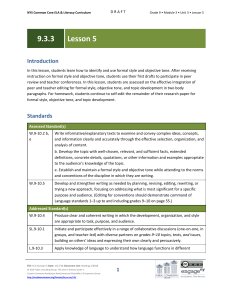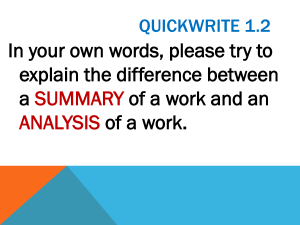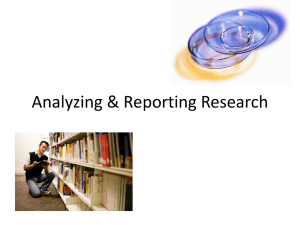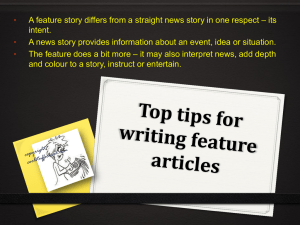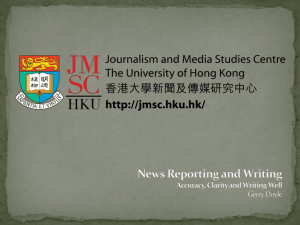Lesson 7 - EngageNY
advertisement
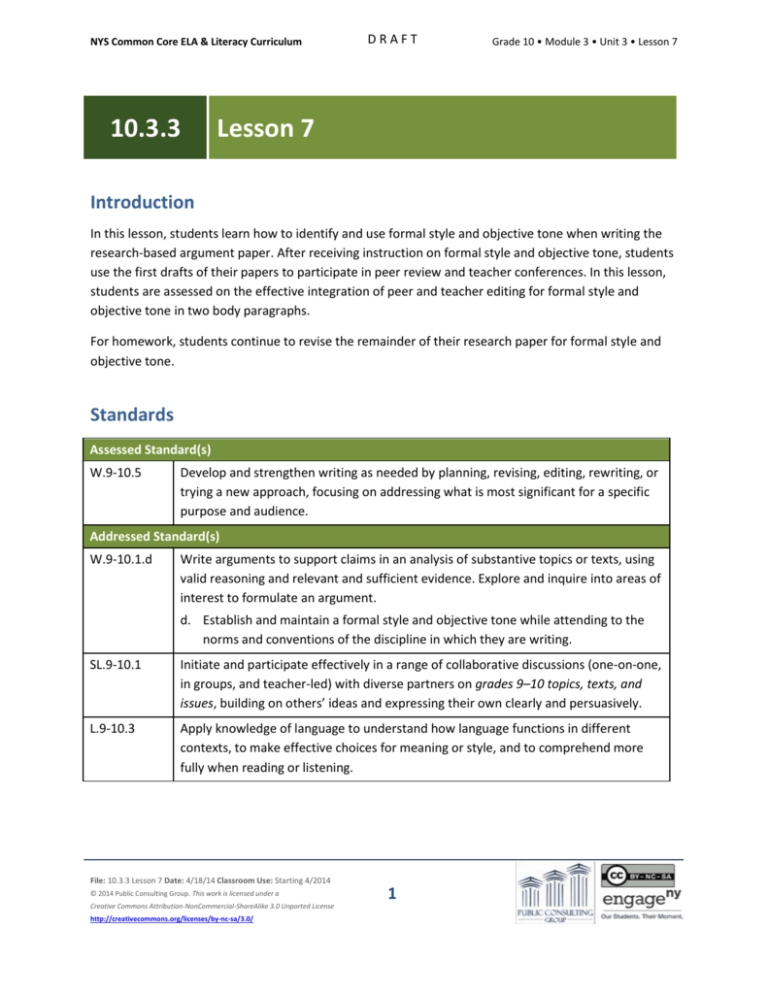
NYS Common Core ELA & Literacy Curriculum 10.3.3 DRAFT Grade 10 • Module 3 • Unit 3 • Lesson 7 Lesson 7 Introduction In this lesson, students learn how to identify and use formal style and objective tone when writing the research-based argument paper. After receiving instruction on formal style and objective tone, students use the first drafts of their papers to participate in peer review and teacher conferences. In this lesson, students are assessed on the effective integration of peer and teacher editing for formal style and objective tone in two body paragraphs. For homework, students continue to revise the remainder of their research paper for formal style and objective tone. Standards Assessed Standard(s) W.9-10.5 Develop and strengthen writing as needed by planning, revising, editing, rewriting, or trying a new approach, focusing on addressing what is most significant for a specific purpose and audience. Addressed Standard(s) W.9-10.1.d Write arguments to support claims in an analysis of substantive topics or texts, using valid reasoning and relevant and sufficient evidence. Explore and inquire into areas of interest to formulate an argument. d. Establish and maintain a formal style and objective tone while attending to the norms and conventions of the discipline in which they are writing. SL.9-10.1 Initiate and participate effectively in a range of collaborative discussions (one-on-one, in groups, and teacher-led) with diverse partners on grades 9–10 topics, texts, and issues, building on others’ ideas and expressing their own clearly and persuasively. L.9-10.3 Apply knowledge of language to understand how language functions in different contexts, to make effective choices for meaning or style, and to comprehend more fully when reading or listening. File: 10.3.3 Lesson 7 Date: 4/18/14 Classroom Use: Starting 4/2014 © 2014 Public Consulting Group. This work is licensed under a Creative Commons Attribution-NonCommercial-ShareAlike 3.0 Unported License http://creativecommons.org/licenses/by-nc-sa/3.0/ 1 NYS Common Core ELA & Literacy Curriculum DRAFT Grade 10 • Module 3 • Unit 3 • Lesson 7 Assessment Assessment(s) Student learning is assessed via incorporation of peer and teacher feedback regarding formal style and objective tone in two body paragraphs. High Performance Response(s) A High Performance Response should: Demonstrate thoughtful consideration of feedback received in class. Incorporate formal style and objective tone into two body paragraphs (e.g., editing from “Selling people’s tissues is totally wrong because it’s going to make the family super worried and stressed out,” to “Furthermore, the sale or resale of human tissue is dehumanizing and exacts a psychological toll on the patient or the patient’s family”). Refer to the sample research paper for further examples of formal style and objective tone. Vocabulary Vocabulary to provide directly (will not include extended instruction) None.* Vocabulary to teach (may include direct word work and/or questions) None.* * Students should use their vocabulary journals to incorporate domain-specific vocabulary from Unit 10.3.2 into their research paper, as well as to record process-oriented vocabulary defined in the lesson. Lesson Agenda/Overview Student-Facing Agenda % of Lesson Standards & Text: Standards: W.9-10.5, W.9-10.1.d, SL.9-10.1, L.9-10.3 Learning Sequence: 1. 2. 3. 4. Introduction of Lesson Agenda Homework Accountability Objective and Formal Tone Peer Review and Teacher Conference 1. 2. 3. 4. File: 10.3.3 Lesson 7 Date: 4/18/14 Classroom Use: Starting 4/2014 © 2014 Public Consulting Group. This work is licensed under a Creative Commons Attribution-NonCommercial-ShareAlike 3.0 Unported License http://creativecommons.org/licenses/by-nc-sa/3.0/ 2 10% 10% 15% 40% NYS Common Core ELA & Literacy Curriculum DRAFT Grade 10 • Module 3 • Unit 3 • Lesson 7 5. Lesson Assessment 6. Closing 5. 20% 6. 5% Materials Student copies of the 10.3 Common Core Learning Standards Tool (refer to 10.3.2 Lesson 1) Student copies of the 10.3.3 Rubric and Checklist (refer to 10.3.3 Lesson 3) Learning Sequence How to Use the Learning Sequence Symbol Type of Text & Interpretation of the Symbol 10% no symbol Percentage indicates the percentage of lesson time each activity should take. Plain text indicates teacher action. Bold text indicates questions for the teacher to ask students. Italicized text indicates a vocabulary word. Indicates student action(s). Indicates possible student response(s) to teacher questions. Indicates instructional notes for the teacher. Activity 1: Introduction of Lesson Agenda 10% Begin by reviewing the agenda and assessed standard for this lesson: W.9-10.5. Inform students that this lesson guides them in using formal style and objective tone for their research-based argument papers. Students engage in peer-review and teacher conferences for the purpose of revising their first drafts. Students look at the agenda. Remind students they were introduced to the standard W.9-10.5 in 10.3.3 Lesson 1. Distribute or ask students to take out their copies of the 10.3 Common Core Learning Standards Tool and read standard W.9-10.1.d. Explain to students that norms means standards or patterns and discipline means the branch of learning. In other words, students should use patterns of writing appropriate for the English Language Arts discipline in which they are writing. Ask students to individually read this standard on their tools and assess their familiarity with and mastery of it. Students read and assess their familiarity with standard W.9-10.1.d. Remind students to record the definitions of norms and discipline in their vocabulary journals. File: 10.3.3 Lesson 7 Date: 4/18/14 Classroom Use: Starting 4/2014 © 2014 Public Consulting Group. This work is licensed under a Creative Commons Attribution-NonCommercial-ShareAlike 3.0 Unported License http://creativecommons.org/licenses/by-nc-sa/3.0/ 3 NYS Common Core ELA & Literacy Curriculum DRAFT Grade 10 • Module 3 • Unit 3 • Lesson 7 Inform students that they focus on W.9-10.1.d today as they revise their first drafts, specifically the part of the standard addressing formal style and objective tone. Students listen. Activity 2: Homework Accountability 10% Instruct students to work in pairs and explain to their peers how their revised body paragraphs better support their concluding statements. Ask students to offer supportive feedback if they notice areas in need of improvement and refer to the W.9-10.1.c portion of the 10.3.3 Rubric and Checklist to guide their review. Students form pairs and take turns explaining how their revised body paragraphs better support their concluding statements, using the W.9-10.1.c portion of the 10.3.3 Rubric and Checklist to guide their discussions. Instruct students to now read each other’s concluding paragraphs and make notes based on the W.910.1.e portion of the 10.3.3 Rubric and Checklist, and then discuss with each other why they made those notes. Student pairs read each other’s concluding paragraphs and make notes based on the W.9-10.1.e portion of the 10.3.3 Rubric and Checklist. Student responses vary based on their individual writing. Activity 3: Formal Style and Objective Tone 15% Share with students the importance in academic writing of maintaining a formal style. Inform students that a formal style is used for writing academic papers in college and the workplace. It is important when writing a research paper to use a formal style because it makes the paper appealing and accessible to a wide audience, in addition to establishing credibility. A formal style uses correct and specific language, correct grammar, and complete sentences. Remind students to avoid the use contractions (e.g., don’t), abbreviations (e.g., gov’t), or slang (e.g., ain’t), unless they are directly quoting from a text that uses such words. Students listen. For further discussion of appropriate formal style, consider using: http://grammar.ccc.commnet.edu/grammar/composition/tone.htm Display two sentences for students: Selling people’s tissues is totally wrong because makes the family feel super worried and stressed out. File: 10.3.3 Lesson 7 Date: 4/18/14 Classroom Use: Starting 4/2014 © 2014 Public Consulting Group. This work is licensed under a Creative Commons Attribution-NonCommercial-ShareAlike 3.0 Unported License http://creativecommons.org/licenses/by-nc-sa/3.0/ 4 NYS Common Core ELA & Literacy Curriculum DRAFT Grade 10 • Module 3 • Unit 3 • Lesson 7 The sale or resale of human tissue is dehumanizing and exacts a psychological toll on the patient or the patient’s family. Ask student pairs to complete a brief Turn-and-Talk discussing which sentence is formal and which is informal. Ask students to explain how they know the differences between the two sentences. The first sentence is informal and the second is formal. The main difference is that the first sentence uses words like totally, it’s, and super. These words sound more casual, like someone is talking to a friend. The second sentence uses more formal and academic words like furthermore, dehumanizing, and exacts. These words make the second sentence seem as if it is from a source that has academic credibility. Differentiation Consideration: Consider offering students some examples of informal vs. formal writing. Inform students that text messages and emails are usually informal, whereas formal writing is found in academic sources, like textbooks, or credible sources like newspapers and published research papers. Consider sharing with students the following source for further discussion of formal vs. informal style: http://blog.ezinearticles.com/2011/03/formal-vs-informal.html. Consider drawing students’ attention to their application of standard L.9-10.3 through the process of applying appropriate knowledge of language to making more effective choices for meaning and style. Explain to students that along with using a formal style in their paper, it is equally important to use an objective tone. When writing with an objective tone, writers should avoid expressing their unverified personal opinions and focus on presenting the information and conclusions gathered from the research. Writing with an objective tone also means using the third person point-of-view (i.e., he, she, it, they, one) instead of the first person point-of-view (i.e., I, we) or the second person point-of-view (i.e., you). Remind students to record the definition of objective tone in their vocabulary journals: objective means “a style of writing not influenced by personal feelings or opinions that is based on fact and makes use of the third person point-of-view.” Display the following examples for students: Profits and personal gain should not take precedence over an individual’s right to privacy, especially in relation to the unique genetic makeup of one’s own body. I don’t think it’s fair at all for profits to be more important than somebody’s private life, because, I mean, come on, this is their body! Ask student pairs to complete a brief Turn-and-Talk to discuss which sentence uses an objective tone. Students complete a Turn-and-Talk in pairs. The first sentence uses objective tone because it does not have “I” or “we” in the sentence. It makes a claim, but does it in a straightforward, unemotional way. The second sentence uses File: 10.3.3 Lesson 7 Date: 4/18/14 Classroom Use: Starting 4/2014 © 2014 Public Consulting Group. This work is licensed under a Creative Commons Attribution-NonCommercial-ShareAlike 3.0 Unported License http://creativecommons.org/licenses/by-nc-sa/3.0/ 5 NYS Common Core ELA & Literacy Curriculum DRAFT Grade 10 • Module 3 • Unit 3 • Lesson 7 phrases like “I don’t think it’s fair,” and “I mean, come on.” It sounds like someone is trying to convince a peer of his/her point of view. Consider creating examples tailored to students' degree of experience and fluency with objective tone. Share with students the definition of subjective tone as “the style of writing that involves personal opinion and expression” and ask students to record the definition in their vocabulary journals. Consider using the evidence-based perspective writing assignment as an example of an informal written assignment that uses the first person point-of-view and subjective tone. Consider adding more practice with formal style and objective tone by instructing students to select and revise one or two sentences from their papers for formal style and objective tone. Students could then share their revised sentences in pairs for feedback. Activity 4: Peer Review and Teacher Conference 40% Inform students that this portion of the lesson is for both peer review and a conference with the teacher. Assign students an individual time to meet with the teacher to receive feedback on their research paper. Direct students to turn to the Coherence, Organization, and Style portion of the 10.3.3 Rubric and Checklist and look for substandard W.9-10.1.d. Remind students to refer to this checklist while reviewing and editing for formal style and objective tone. Remind students that in this lesson, they continue the work of collaborative discussion practices outlined in SL.9-10.1, to which students were introduced in previous modules. The peer review and teacher conference continues in the following lesson, 10.3.3 Lesson 8. Students read W.9-10.1.d on their 10.3.3 Rubric and Checklist and discuss in pairs before beginning the review of their peer’s body paragraphs. Inform students they are only going to focus on the formal and objective tone elements of this substandard. Differentiation Consideration: Consider instructing students to mark W.9-10.1.d on their 10.3.3 Rubric and Checklist to concentrate their focus on this substandard only. Encourage students to keep in mind the Module Performance Assessment as they practice the skills inherent in the Speaking and Listening Standards during this discussion activity. Remind students that they present their research orally at the end of the module and that this activity provides an opportunity to begin preparing for the assessment presentation. Instruct students who are scheduled for individual conferences to meet with the teacher to discuss their research paper. Students scheduled for individual conferences meet with the teacher. File: 10.3.3 Lesson 7 Date: 4/18/14 Classroom Use: Starting 4/2014 © 2014 Public Consulting Group. This work is licensed under a Creative Commons Attribution-NonCommercial-ShareAlike 3.0 Unported License http://creativecommons.org/licenses/by-nc-sa/3.0/ 6 NYS Common Core ELA & Literacy Curriculum DRAFT Grade 10 • Module 3 • Unit 3 • Lesson 7 These conferences provide an opportunity to support individual students throughout the writing process. Consider tailoring the conferences to meet individual student needs. Instruct students who are not currently in an individual teacher conference to meet in their preestablished research teams for peer review while other students have their independent teacher conferences. Remind students to peer review for W.9-10.1.d using the relevant portion of the 10.3.3 Rubric and Checklist. Students gather for peer review. Activity 5: Lesson Assessment 20% Instruct students to begin revising two body paragraphs independently, based on peer and teacher feedback regarding formal style and objective tone. Students revise the entire paper for formal style and objective tone for homework. Inform students that the assessment is based on their editing and incorporation of peer and teacher feedback. Inform students that this assessment is evaluated using the W.9-10.d portion of the 10.3.3 Rubric and Checklist. Remind students to refer to the checklist as they are writing their conclusions. Students revise two of the body paragraphs of their paper based on peer and teacher feedback regarding formal style and objective tone. See the High Performance Response at the beginning of this lesson. Activity 6: Closing 5% Display and distribute the homework assignment. For homework, instruct students to review and revise all of the body of their research paper to ensure they are using formal style and objective tone. Remind students to refer to substandard W.9-10.1.d on the 10.3.3 Rubric and Checklist to guide their revisions. Students follow along. Homework Review and revise your entire research paper for formal style and objective tone using W.9-10.1.d on the 10.3.3 Rubric and Checklist to guide your review and revisions. File: 10.3.3 Lesson 7 Date: 4/18/14 Classroom Use: Starting 4/2014 © 2014 Public Consulting Group. This work is licensed under a Creative Commons Attribution-NonCommercial-ShareAlike 3.0 Unported License http://creativecommons.org/licenses/by-nc-sa/3.0/ 7
